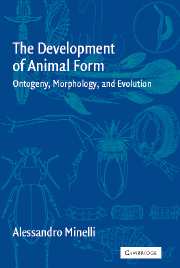Book contents
- Frontmatter
- Contents
- Preface
- Acknowledgements
- 1 The Nature of Development
- 2 Everything Begun to the Service of Development: Cellular Darwinism and the Origin of Animal Form
- 3 Development: Generic to Genetic
- 4 Periodisation
- 5 Body Regions: Their Boundaries and Complexity
- 6 Differentiation and Patterning
- 7 Size Factors
- 8 Axes and Symmetries
- 9 Segments
- 10 Evo-devo Perspectives on Homology
- Summary and Conclusions
- References
- Index
4 - Periodisation
Published online by Cambridge University Press: 10 August 2009
- Frontmatter
- Contents
- Preface
- Acknowledgements
- 1 The Nature of Development
- 2 Everything Begun to the Service of Development: Cellular Darwinism and the Origin of Animal Form
- 3 Development: Generic to Genetic
- 4 Periodisation
- 5 Body Regions: Their Boundaries and Complexity
- 6 Differentiation and Patterning
- 7 Size Factors
- 8 Axes and Symmetries
- 9 Segments
- 10 Evo-devo Perspectives on Homology
- Summary and Conclusions
- References
- Index
Summary
Stages exist in the mind of the biologist, not in the larva. All that is needed in order to recognize a stage is a fixed starting and finishing point.
C.S. Hickman 1999: 27For centuries, philosophers have been discussing continuity versus discontinuity. I embrace the view that these questions depend on the tools we adopt in measuring and describing phenomena: “we need not suppose that the material world is fundamentally discontinuous, it does appear that some continuities involve steeper gradients than other” (Ahl and Allen 1996: 166). This applies to the spatial (structural, morphological), as well as the temporal (ontogenetic) dimension. It was previously described how arbitrary it is to cut the fundamental continuity of life into individual life cycles. In this chapter, I will identify additional problems with the periodisation of a life cycle, that is articulating it into meaningful and comparable temporal units. Corresponding problems with morphological units, such as segments or teeth, will be discussed in the last two chapters of this book.
A study of the spatial aspects of development – such as segmentation, tagmosis or the positioning of the appendages – makes little sense if not coupled with research into the temporal dimension of ontogeny. A distinction between temporal and spatial aspects of the molecular control of development is often artificial.
- Type
- Chapter
- Information
- The Development of Animal FormOntogeny, Morphology, and Evolution, pp. 55 - 78Publisher: Cambridge University PressPrint publication year: 2003



